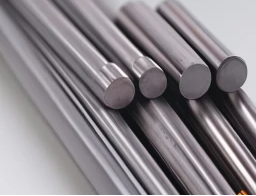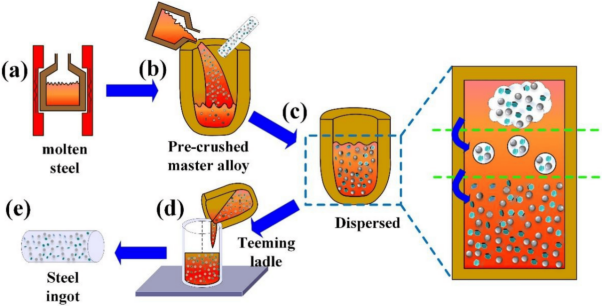H13 Tool Steel: Properties, Applications, and Machining Considerations
 Jul 26,2024
Jul 26,2024

AISI H13 is a versatile alloy. It is preferred for applications like hot forging, die casting and extrusion. These require high-temperature steel and die steel. It is widely employed in injection molding and die casting production. More information about the properties, applications, benefits and limitations of AISI H13 is discussed in this article.
What is H13 Steel?
H13 steel also refers as DIN 1.2344 is chromium-molybdenum based hot work steel. it is known as high-temperature steel and die steel due to high temperature and abrasion resistance. high hot hardness increases its thermal fatigue cracking resistance and is preferred for tooling applications

Key Characteristics
The key features of DIN 1.2344 are as follows:
- Known as hot work steel, die steel and high-temperature steel.
- High abrasion resistance under low and high temperatures conditions.
- Higher toughness and malleability
- High machinability and polishing feature
- Better high temperature and thermal cracking resistance.
- High thermal conductivity and hot cracking resistance
- H13 material HRC hardness is high
- Less distortion in work hardening
Best Cutting Tools for H13
Cutting tools are of different grades based on their chemical composition, mechanical and physical properties. ideal tool steels for machining are O1, M2, D2 and A2. Other important aspects are speed levels. Inappropriate tool selection could reduce the hardness and wear resistance with time. Therefore, it is best to manufacture tool with high-speed steel. The cost of cutting tool is also important to ensure material is suitable enough to result the required performance.
|
Cutting tool steel |
Best features |
|
O1 |
Better Hardness and machinability |
|
M2 |
Hardness and toughness |
|
A2 |
Balanced Toughness and wear resistance |
|
D2 |
Toughness and wear resistance |
H13 Steel Equivalent Materials
The equivalent grades of AISI H13 steel are:
|
Country |
Grade |
Equivalent material |
|
USA |
AISI/SAE |
H13 |
|
Europe |
EN |
X40CrMoV5-1 |
|
Germany |
DIN, WNr |
X40CrMov5-1 |
|
China |
GB |
4Cr5MoSiV1 |
|
Japan |
JIS |
SKD61 |
|
india |
IS |
XT35CrMoV1ST |
|
R. of Korea |
KS |
STD61 |
|
Russia |
GOST |
4Ch4VMFS |
Cost
AISI H13 cost depends on many factors like market rate, suppliers, form of hot work steel, size, quality and processing requirement. The rough estimate of DIN1.2344 is around $1500-3500/metric ton.
Pros and Cons of H13 Mold Steel
The pros of AISI H13 or SKD 61 high temperature steel are as:
- Maintains a good balance between toughness and H13 material HRC hardness.
- Survive high temperature while maintaining its strength and hardness
- High thermal cycling fatigue resistance suitable for applications as hot work steel.
- Good machinability to make intricate and complex shapes.
- Wear resistance is excellent because of high hardness
- Has many applications such as hot work steel, die steel and high temperature steel.
Along with these advantages, there are few limitations in the application of DIN 1.2344 steel which are as:
- Corrosion resistance is moderate and harsh corrosive agents can affect the performance of tool or die made of AISI H13.
- Can be costly with other high-temperature steel.
- Specific and precise heat treatments in high-temperature steel. are required to attain desired properties which makes it costly.
- Weldability is limited and cracking can occur in welds in high-temperature steel.
H13 Tool Steel Applications
- Injection molds and dies
AISI H13 steel is used to manufacture injection molds and die-casting because of high h13 material HRC hardness. It is employed in flip cap molds. Other industries also prefer this because of high toughness and wear resistance.
- Extrusion dies
SKD61 has high thermal properties. This makes it perfect for extrusion dies. Extrusion mandrels and cores are also made of AISI H13 due to high heat resistance.
- Hot forging dies
High thermal properties make it useful in hot forging applications. It is also employed in making dies, inserts and other parts requires in hot forging applications.
- Pressure casting dies
SKD61 is mostly employed as tooling steel for Aluminum pressure die casting. It is best for hot gripper dies and hot nut tools.
- Other high-temperature tooling
There are also other applications of DIN 1.2344 steel in the production of plastic molds. This material is favorable in applications like die holder blocks, hot press dies and hot work punches.
The Composition and Properties of H13 Material
Chemical composition of AISI H13 material is as:
Detailed chemical composition
The table include the chemical composition of AISI H13.
|
Elements |
Percentage (max) |
|
Fe |
Balanced |
|
C |
0.45 |
|
Cr |
5.5 |
|
Mo |
1.75 |
|
V |
1.2 |
|
Si |
1.2 |
|
Ni |
0.3 |
|
Cu |
0.25 |
|
Mn |
0.5 |
|
P |
0.03 |
|
S |
0.03 |
How alloying elements influence performance
Major alloying elements in SKD61 steel are chromium, vanadium and molybdenum. Cr increases the H13 material HRC hardness of and its toughness. It also increases the corrosion resistance in high temperature steel. Mo increases the hardenability, toughness and strength in DIN 1.2344 steel. vanadium increases the yield and tensile strength in steels.
The preparation process of H13 tool and die steels manipulated by trace nanoparticles: (a) melt, (b) addition and release of nanoparticles, (c) uniform distribution of nanoparticles, (d) casting, (e) steel ingot

Density
The density of AISI H13 at 20℃ is 7.8g/cm3.
Mechanical properties
The mechanical properties of SKD61 are as follows:
|
Mechanical properties |
Values |
|
Melting point |
1427℃ |
|
Ultimate Tensile strength |
1590MPa |
|
Yield strength |
1380MPa |
|
Reduction of area |
50% |
|
Elastic modulus |
215GPa |
|
Poisson’s ratio |
0.3 |
|
Machinability |
55% |
|
Thermal conductivity |
17.6W/m℃ |
|
Thermal expansion coefficient |
10.8 10-4m/mK |
Heat Treatment of H13 Steel
Importance of proper heat treatment
AISI H13 are heat treated to get high performance in terms of high strength, hardness and high impact resistance and toughness.
Hardening H13 Tool Steel
AISI H13 is pre-heated to 816℃ and then temperature is rose up to 1010℃. Holding time is 15-40 mins which is then air-quenched to harden the H13 tool steel.
Tempering H13 Tool Steel
Tempering is normally in the range 550-621℃ in SKD61. The hardness at different tempering temperatures is as follows:
|
Tempering ℃ |
H13 material HRC Hardness |
|
100 |
54 |
|
210 |
53 |
|
300 |
53 |
|
400 |
55 |
|
500 |
56 |
|
550 |
54 |
|
600 |
51 |
|
650 |
43 |
|
700 |
34 |
Annealing
AISI H13 is annealed to 1600ᵒF and then furnace cooled to 900ᵒF at 30ᵒ/hour. Then the material is air cooled.
Recommended temperatures and durations
Recommended temperature for SKD61 heat treatment is 800-1000℃. The duration to hold the material is around 15-40 mins to get optimum properties.
Achieving optimal hardness and toughness
Depending on the temperature cooling rate and holding time, optimum hardness and toughness can be achieved in SKD61.
|
Heat treatment properties |
Values |
|
Annealing |
810℃ |
|
Cooling |
Furnace |
|
Harndess |
240HB |
|
Stress-relief annealing |
660℃ |
|
Hardening |
1060℃ |
|
Quenching |
Oil, air salt |
|
Hardness |
55 HRC |
Machining AISI H13 Tool Steel
Tips for Successful Machining
Hardness is greatest of concern in SKD61 machining. Carbide tools with coating are recommended to use. Coolant like water soluble coolants help to dissipate heat while machining. Pre and post treatments mat be necessary such as surface finishing or heat treatment.
Challenges and considerations
Challenges in DIN 1.2344 tool steel machining are its high hardness and toughness and high heat generation. It is necessary to select an appropriate cutting tool, cutting parameters like speed levels and using coolant to dissipate generate heat.
On the correlation between processing parameters, plastic deformation, and mechanical property in hard machining of H13 steel.

Welding
Welding of SKD61 has limitations. Welds are prone to cracking and therefore, preheating is necessary to maintain suitable interpass temperature. Post welding treatment can reduce the residual stress and cracking risk.
Tuofa China expertise in H13 machining
Tuofa CNC machining specializes in tool steel CNC machining. Tuofa offers high-quality steel products to meet the desired criteria of your project. We are specialized in cutting tools, forming tools, injection molding and die steel. Our expertise ensures the right material selection for your project. For more information, please visit: https://www.tuofa-cncmachining.com/
Advanced Topic: Comparison with other Stainless Steels
H11 vs H13 Steel
H11 has less vanadium than DIN 1.2344. H11 has higher toughness but less wear resistance and tempering resistance.
H13 Steel vs 4140
H13 has high hardness and heat resistance. 4140 has high toughness.
H13 Steel vs P20
DIN 1.2344 is suitable for molds and for high-production volume. P20 is more suitable for low production volume of molds and is less costly.
H13 vs. D2
D2 has higher hardness than DIN 1.2344 and is better tool steel.
 Tel/WeChat:
Tel/WeChat:  Email:
Email: 
 Home
Home
 Understanding 2000 Series Aluminium Alloys in Aerospace
Understanding 2000 Series Aluminium Alloys in Aerospace 







